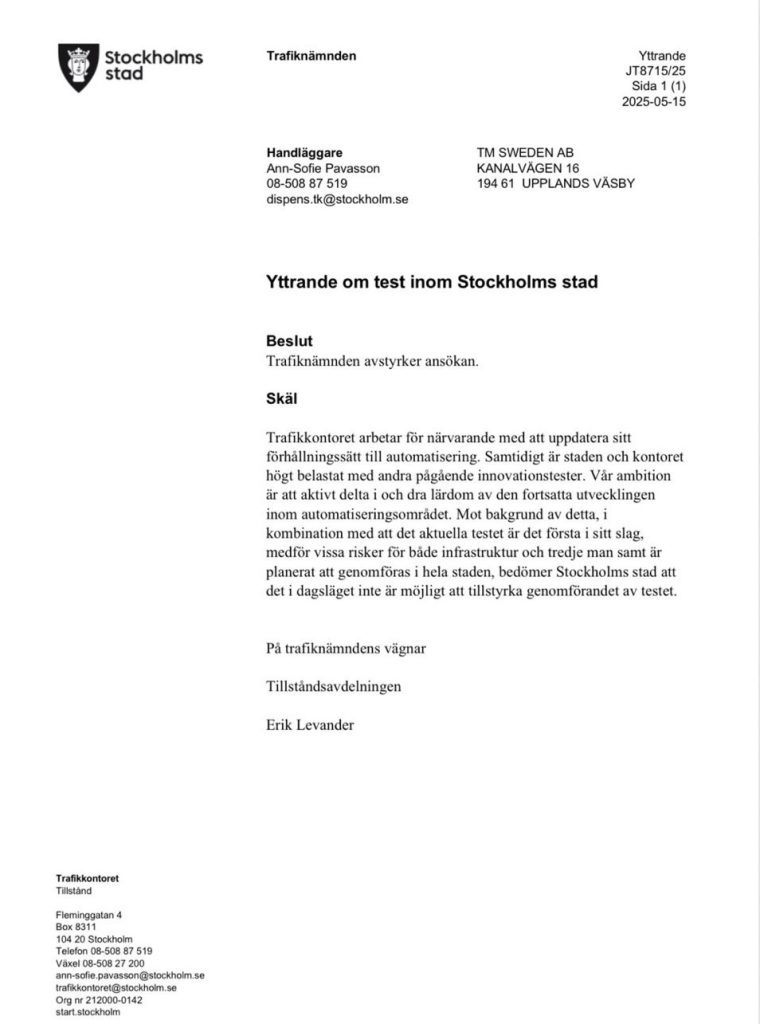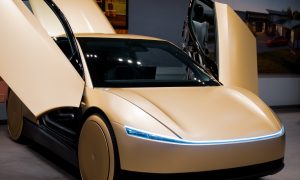News
Tesla features used to flunk 16-year-old’s driver license test
A license examiner in New Jersey confused one standard feature of Teslas as a way a 16-year-old excelled through his driver’s test. He failed him because of it.

In what is becoming a more common occurrence, a few Tesla features were used to flunk a 16-year-old who took his driver’s license test in New Jersey.
It is not the first time this has happened, as we have reported on several instances of this in the past, both in the U.S. and other countries in the world.
It is evidence that some officials are not caught up in the technology and innovation occurring in the automotive market, some of which is not necessarily exclusive to Tesla, but is included in each of its models, unlike other companies.
Lochlan Keefer, a New Jersey resident, showed up to his driver’s test with his dad, James, in their 2022 Tesla Model Y. However, the test did not go according to plan, according to the examiner who rode along for the test with Lochlan. They accused him of using parking and “stopping assistance” to go through the test.
The examiner cited the following as the reason for failure:
“Had the parking and stopping assistance on never stepped on the brake to stop his self let the vehicle stop it self.”
James said to NJ.com that they do not subscribe to Tesla’s Full Self-Driving suite, which includes things like Autopark, Navigate on Autopilot, and Autosteer on City Streets. These are a few of the things that have been used as reasoning to fail drivers in tests. Lochlan’s was a case of regenerative braking, which is standard on all vehicles, and Autopark:
“The examiner accused my son of using driver assistance features simply because he parallel parked smoothly on the first try. He was specifically accused of using paid parking-assist and driving features, which we do not subscribe to.”
It sounds as if the examiner may have confused the braking mishap for Tesla’s regenerative braking, which slows the vehicle when the accelerator is not pressed. The energy is then stored back in the battery to help with range.
The examiner failed Lochlan, and James asked if he could take the test again if they disabled the regenerative braking for the exam. The examiner said Lochlan would have to wait two weeks. A supervisor came out and backed the examiner, but James said the policy the DMV claimed the Keefer’s violated was nowhere to be found:
“I asked them to show me the policy they claimed we were violating. They couldn’t find it and they couldn’t cite it. When I showed them the policy, they refused to read it.”
The report states that drivers in California and Arizona have also been subjected to failures on their driving tests due to confusion over Teslas and their driver assistance features.
News
Sweden blocks Tesla FSD-style testing in Stockholm
It looks like FSD testing in Sweden would have to wait some time.

Tesla is putting a lot of effort into getting its Full Self Driving (FSD) system approved in territories outside North America. But while China seems to have embraced FSD fully, other countries like Sweden do not seem to be receiving Tesla’s automated driving system very well.
This became quite evident in a document from Stockholm City, which has started making the rounds online.
FSD Testing Rejected
The document, which was initially shared by X user @KRoelandschap, indicated that the Swedish Traffic Department in Stockholm had rejected Tesla’s request to start FSD testing in the city’s streets. Tesla has been demonstrating FSD in several areas across Europe, so it is not surprising that the company is also attempting to test its automated driving system in Sweden.
Unfortunately for Tesla, Sweden might prove to be a tough nut to crack. As per the City of Stockholm:
“The Traffic Office is currently working on updating its approach to automation. At the same time, the city and the office are under heavy pressure from other ongoing innovation tests. Our ambition is to actively participate in and learn from the continued development in the field of automation.
“Based on this, and in combination with the fact that the current test is the first of its kind, which entails certain risks for both infrastructure and third parties, and that it is planned to be carried out throughout the city, the City of Stockholm considers it is currently not possible to approve the implementation of the test.”


Tesla’s Other Swedish Troubles
Sweden’s FSD testing rejection is not the only roadblock facing Tesla in the country. Since October 2023, Swedish unions have been engaged in an active effort to disrupt Tesla’s operations. The unions’ efforts have been varied, with some resulting in Tesla having difficulty launching more Superchargers in Sweden. Despite this, Tesla has remained stubborn and has refused to bow to the unions’ demands.
Fortunately for Tesla, it seems like its numbers are still strong. Despite the company’s decline in several European countries, the new Model Y is starting to see strong sales figures in Sweden. In early May alone, the new Model Y became the country’s most popular electric vehicle—a notable accomplishment considering the unions’ active efforts to disrupt Tesla.
News
Tesla firmware shows new Model Y seat configuration is coming
Tesla could be adding another seating configuration beside the seven-seater to the Model Y lineup later this year.

Tesla firmware has been a great place for some to reveal what the company has in the pipeline, and a new seating configuration for the best-selling Model Y looks to be on the way.
Last week, we reported that Tesla was already hinting toward a 7-seater configuration of the Model Y in a promotional email it sent to those on its contact list.
However, firmware revealed by Tesla hacker greentheonly is showing that a new seating configuration is on the way — a six-seater:
The much rumored about 6-seater Model Y made an appearance in the firmware.
Unlikely to be China-only as some of the speculations said.Some weird “slow down to save energy, people typically drive this much slower here to save %%” nav suggestions.
— green (@greentheonly) June 16, 2025
Green says the configuration would not be available in China-only, and will be potentially for sale in other markets as well.
The six-seat and seven-seat configurations of the Model Y were available in the Legacy version of the vehicle, but were met with mixed reviews, as many complained about the lack of legroom in the third row.
This was something that was a real concern for many of those owners who needed something larger than the traditional five-seat variant, but did not want to buy the much more pricey Model X.
We’ve covered the size of that third row on several occasions.
Some owners even took the idea of having a seven-seater into their own hands:
Tesla Model Y third row seat test explores options for a comfortable 7-seat setup
Tesla did not explicitly announce a six-seater configuration of the Model Y, but Lars Moravy, the company’s VP of Vehicle Engineering, said the seven-seater would come to production later in 2025.
News
Tesla confirms massive hardware change for autonomy improvement
Tesla has confirmed that a recent change made to some of its recently refreshed vehicles is, in fact, a strategy it will use to improve its suite as it continues to work toward autonomy.

Tesla has confirmed that a recent change made to some of its recently refreshed vehicles is, in fact, a strategy it will use to improve its suite as it continues to work toward autonomy.
Tesla first introduced a front-facing camera on the front bumper with the Cybertruck.
Then, the Model Y “Juniper” received the hardware update. The Model S and Model X both received the front-facing camera with its latest update, which was officially revealed last week.
Tesla used new language with the release of the front-facing cameras on the Model S and Model X, confirming they will assist with several things, including “using Autopilot and Actually Smart Summon capabilities”:
“Enhanced visibility when parking or using Autopilot and Actually Smart Summon capabilities.”
This tiny feature on the new Tesla Model Y is perhaps its biggest addition
This is the first time Tesla has used this sort of language, as it was a completely different description with the launch of the new Model Y in January.
When Tesla launched this vehicle, it said the front bumper camera “provides a wider field of view for automatic assisted driving and advanced Smart Summon.”
Tesla switched from using cameras and sensors to only cameras with the launch of Tesla Vision several years ago. The company’s utilization of cameras comes from Tesla’s belief that Ultrasonic Sensors (USS) are not needed for self-driving efforts:
“Along with the removal of USS, we simultaneously launched our vision-based occupancy network – currently used in Full Self-Driving (FSD) (Supervised) – to replace the inputs generated by USS. With today’s software, this approach gives Autopilot high-definition spatial positioning, longer range visibility and the ability to identify and differentiate between objects. As with many Tesla features, our occupancy network will continue to improve rapidly over time.”
CEO Elon Musk has said that sensors were only a crutch and that self-driving would be solved through the use of cameras:
“When your vision works, it works better than the best human because it’s like having eight cameras, it’s like having eyes in the back of your head, beside your head, and has three eyes of different focal distances looking forward. This is — and processing it at a speed that is superhuman. There’s no question in my mind that with a pure vision solution, we can make a car that is dramatically safer than the average person.”
-

 News1 week ago
News1 week agoI took a Tesla Cybertruck weekend Demo Drive – Here’s what I learned
-

 Elon Musk2 weeks ago
Elon Musk2 weeks agoElon Musk explains Tesla’s domestic battery strategy
-

 Elon Musk2 weeks ago
Elon Musk2 weeks agoTesla stock: Morgan Stanley says eVTOL is calling Elon Musk for new chapter
-

 Elon Musk1 week ago
Elon Musk1 week agoTesla tops Cathie Wood’s stock picks, predicts $2,600 surge
-

 Elon Musk2 weeks ago
Elon Musk2 weeks agoElon Musk responds to Tesla Supercharger shutdown on NJ Turnpike
-

 News2 weeks ago
News2 weeks agoTesla is missing one type of vehicle in its lineup and fans want it fast
-

 News6 days ago
News6 days agoFirst Tesla driverless robotaxi spotted in the wild in Austin, TX
-

 Elon Musk2 weeks ago
Elon Musk2 weeks agoSpaceX to decommission Dragon spacecraft in response to Pres. Trump war of words with Elon Musk


















